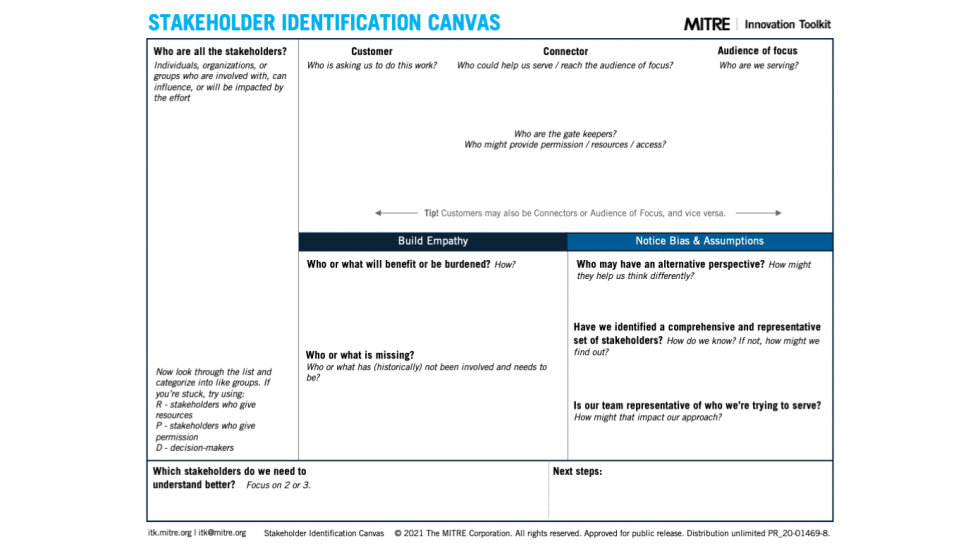Learn more about ITK’s newest tool and the equity lens embedded in it.
– – –
As part of Team Toolkit’s collaboration with the MITRE Social Justice Platform, we are excited to announce the addition of a new tool – the ITK Stakeholder Identification Canvas!
The ITK Stakeholder Identification canvas helps your team ideate a more comprehensive & representative set of relevant stakeholders to your project. In addition, this tool embeds an equity lens to help your team be mindful of the needs and priorities of the larger community, which may not be immediately apparent.
As a refresher, recall that equity-driven design thinking encourages us to create not just inclusive and diverse solutions, but to create equitable solutions. Equitable solutions are available to all (e.g., equal access), and they also help equalize who benefits from the solution (e.g., many groups benefit, not just one).
Equity-driven design thinking helps ensure we design at the margins or at the “edge,” where those with the greatest need exist. These are the groups who are left out because they don’t have a seat the table, a voice, and/or the means to advocate for themselves.
For example, edge groups may not have power or resources; they may represent only a small portion of the overall set and are not included in the “average audience”; and/or the project doesn’t engage with them because the project team believes there isn’t enough time if they want to meet project deadlines. It’s critical to include these edge groups because not only does their inclusion often yield a better solution for many, it’s also often the case that these edge groups are the ones most likely to suffer the greatest burden or consequences of inequitable design.
So, what happens if your team is looking at the wrong “edge”? What if your team thinks they’re designing at the margin, but there’s actually more groups they should be considering?
That’s where the ITK Stakeholder Identification canvas comes in!
The ITK Stakeholder Identification canvas encourages teams to broaden their thinking by asking not only about primary stakeholders, but also about secondary and tertiary stakeholders. This helps teams build a more comprehensive set of groups to consider.
Potential secondary stakeholders could be groups that play a connector role. These stakeholders could be gate keepers, or they might provide permission, resources, or access to enable (or block) your project’s success. And of course, it’s critical for the team to identify the actual audience of focus that will receive the outcome or benefit that your project seeks to create, which may be a different group than your primary stakeholders.
In addition, the embedded equity lens asks teams to consider potential tertiary stakeholders that may be even less visible. In the “Build Empathy” section, teams are asked to consider who or what will be benefitted or burdened. This section also asks teams to consider who or what may be missing, with a sub-prompt to also consider historical actions. By asking about “what,” rather than only “who,” this expands the set of potential stakeholders to include organizations, communities, ecosystems, the environment, and more. Oftentimes, answering these questions will further broaden your team’s thinking to consider systemic and intergenerational impacts.
Lastly, it wouldn’t be an equity-centered tool if there wasn’t at least one question about biases. Fortunately, this tool has 3!
The “Notice Bias & Assumptions” section includes three prompts to encourage honest self-awareness on the team about how their perspectives may be limited or non-representative of the audience of focus. Answering these questions will also help identify if there are gaps in the stakeholder set, which means there is further information gathering or research that needs to be completed by the team.
The ITK Stakeholder Identification canvas is best used early in the process, but it’s an important step whenever you need to consider who or what is involved, interested, or impacted by your project. For true project success, it’s essential to consider and involve not only those who are actively involved in your project, but also those whose interests may be positively or negatively affected by your effort.
Get your copy of the ITK Stakeholder Identification canvas here. We hope you find it useful, and let us know what you think in the comments below!
Interested in learning more about other ITK tools with an embedded equity lens?
- Check out the updated Problem Framing canvas and the accompanying ITK blog article which explains our equity lens update to our toolkit
- Read more about Team Toolkit’s equity-driven efforts here
- Click on the equity driven design category to the right to filter for equity-related blog articles
- Sign up for our mailing list to get the latest updates as more tools are released!

